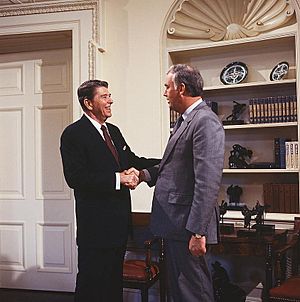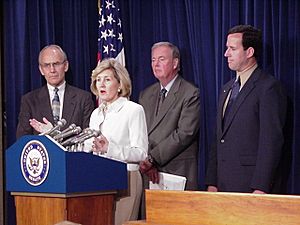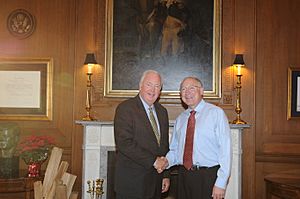Frank Murkowski facts for kids
Quick facts for kids
Frank Murkowski
|
|
|---|---|

Murkowski in 1992
|
|
| 8th Governor of Alaska | |
| In office December 2, 2002 – December 4, 2006 |
|
| Lieutenant | Loren Leman |
| Preceded by | Tony Knowles |
| Succeeded by | Sarah Palin |
| United States Senator from Alaska |
|
| In office January 3, 1981 – December 2, 2002 |
|
| Preceded by | Mike Gravel |
| Succeeded by | Lisa Murkowski |
| 3rd Alaska Commissioner of Economic Development | |
| In office December 5, 1966 – December 7, 1970 |
|
| Governor | Wally Hickel Keith Miller |
| Preceded by | William Dickson |
| Succeeded by | Everett Buness |
| Personal details | |
| Born |
Frank Hughes Murkowski
March 28, 1933 Seattle, Washington, U.S. |
| Political party | Republican |
| Spouse |
Nancy Murkowski
(m. 1954) |
| Children | 6, including Lisa |
| Education | Seattle University (BS) |
| Military service | |
| Allegiance | United States |
| Branch | United States Coast Guard |
| Service years | 1955–1957 |
Frank Hughes Murkowski (born March 28, 1933) is an American politician. He is a member of the Republican Party. He served as a United States Senator for Alaska from 1981 to 2002. Later, he became the eighth governor of Alaska, serving from 2002 to 2006.
Murkowski first ran for a seat in the U.S. House of Representatives for Alaska in 1970. He lost that election. In 1980, he was elected to the United States Senate. He was reelected three more times: in 1986, 1992, and 1998.
In 2002, Murkowski ran for governor of Alaska. He won the election and became governor on December 2, 2002. Before becoming governor, he resigned from his Senate seat. He then appointed his daughter, Lisa Murkowski, to take his place in the Senate. In 2006, he tried to be reelected as governor but finished third in the Republican primary election.
Contents
Early Life and Education
Frank Murkowski was born in Seattle, Washington. His parents were Helen and Frank M. Murkowski. His grandfather on his father's side had Polish roots.
Murkowski went to Ketchikan High School in Alaska and graduated in 1951. He studied at Santa Clara University for two years. In 1955, he earned a Bachelor of Science (BS) degree in economics from Seattle University.
He joined the United States Coast Guard in the summer of 1955. He served until 1957. During his service, he was stationed in Sitka and Ketchikan, Alaska. He also served on the Coast Guard ships Sorrel and Thistle.
Political Career
After working at a bank and studying more, Murkowski became Alaska's Commissioner of Economic Development at age 33. This made him the youngest commissioner at that time. In 1971, he became the president of the Alaska National Bank of the North. He also led the Alaska Bankers Association and the Alaska State Chamber of Commerce.
He ran for Alaska's only U.S. House seat in 1970. However, he was defeated by Democratic state Senator Nick Begich Sr..
Serving in the U.S. Senate
Frank Murkowski was first elected to the U.S. Senate in 1980. He won with 54% of the vote. He was re-elected in 1986, 1992, and 1998.
During his time in the Senate, he was the Chairman of the Energy and Natural Resources Committee. This was from 1995 to 2001. As chairman, he tried to open the Arctic National Wildlife Refuge for oil drilling, but this effort was not successful.
Becoming Governor of Alaska

Murkowski was elected governor on November 5, 2002. He received almost 56% of the votes. This was the highest percentage for any Republican governor candidate in Alaska's history at that time. He took office on December 2, 2002.
When he became governor, he resigned from his Senate seat. He then appointed his daughter, Lisa Murkowski, to fill his vacant Senate seat. This appointment was criticized by some people.
Toward the end of his time as governor, he worked on a deal for a gas pipeline. This deal was never fully approved by the state legislature.
Governor Murkowski ran for re-election in 2006. However, he came in third place in the Republican primary election. Former Wasilla Mayor Sarah Palin won the primary. Murkowski left office with low approval ratings.
In total, Frank Murkowski spent 27 years in public service. This included two years in the armed services, 21 years as a U.S. Senator for Alaska, and four years as governor. He considered running for governor again in 2018 but decided not to.
State Jet Purchase
In 2005, Governor Murkowski bought a Westwind II jet for the state. It cost $2.7 million. This purchase was made despite opposition from the Alaska Legislature. The jet became a symbol of his unpopular decisions. His successor, Sarah Palin, promised to sell the jet once she became governor.
Election Results
- United States House of Representatives election in Alaska, 1970
- Nick Begich (D), 55%
- Frank Murkowski (R), 45%
- United States Senate election in Alaska, 1980
- Frank Murkowski (R), 54%
- Clark Gruening (D), 46%
- United States Senate election in Alaska, 1986
- Frank Murkowski (R) (incumbent), 54%
- Glenn Olds (D), 44%
- United States Senate election in Alaska, 1992
- Frank Murkowski (R) (incumbent), 53%
- Tony Smith (D), 38%
- Mary Jordan (Green), 8%
- United States Senate election in Alaska, 1998
- Frank Murkowski (R) (incumbent), 75%
- Joe Sonneman (D), 20%
- 2002 Alaska gubernatorial election
- Frank Murkowski (R), 56%
- Fran Ulmer (D), 41%
- 2006 Alaska gubernatorial election (Republican primary)
- Sarah Palin (R), 51%
- John Binkley (R), 30%
- Frank Murkowski (R) (incumbent), 19%
See also
 In Spanish: Frank Murkowski para niños
In Spanish: Frank Murkowski para niños





